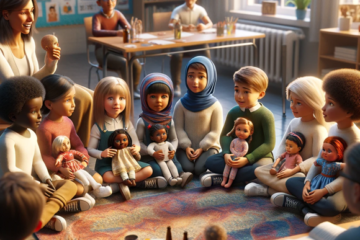In a world where screens dominate children’s attention, the simplicity of a doll often gets overlooked. Yet, beneath its unassuming exterior lies a powerful tool for nurturing essential life skills: problem-solving and decision-making. From classic dolls to modern iterations, these timeless toys play a significant role in shaping young minds, fostering creativity, empathy, and critical thinking.
A Journey into Childhood Imagination
Dolls have been companions to children for centuries, transcending cultural boundaries and evolving with time. Through imaginative play, children project themselves into various scenarios, assuming different roles and responsibilities. This imaginative process serves as a sandbox for developing problem-solving skills. Whether dressing up a doll for a tea party or enacting a doctor-patient scene, children encounter challenges that require creative solutions.
Empathy and Understanding
The relationship between a child and their doll goes beyond superficial play; it cultivates empathy and emotional intelligence. As children care for their dolls, they learn to anticipate needs, empathize with feelings, and make decisions based on compassion. These early experiences lay the groundwork for understanding complex social dynamics and navigating interpersonal relationships later in life.
The Power of Choice
Every interaction with a doll presents an opportunity for decision-making. From selecting outfits to planning imaginary adventures, children constantly weigh options and make choices. These seemingly trivial decisions, however, contribute to the development of decision-making skills. Through trial and error, children learn to assess consequences, prioritize preferences, and adapt their choices—a fundamental aspect of problem-solving in real-world scenarios.
Problem-Solving Through Play
Play is the language of childhood, and dolls serve as versatile tools for problem-solving. Whether faced with a missing accessory or a wardrobe malfunction, children engage in a process of trial and error, experimentation, and improvisation to overcome obstacles. These playful challenges stimulate cognitive development, fostering resilience and adaptability—a crucial foundation for navigating life’s complexities.
Breaking Gender Stereotypes
Dolls have historically been associated with girls’ play, perpetuating gender stereotypes. However, breaking free from these confines is essential for fostering inclusive learning environments. All children, regardless of gender, can benefit from the cognitive and emotional development facilitated by doll play. Encouraging boys to engage with dolls promotes empathy, communication skills, and a holistic understanding of diverse perspectives.
Modern Innovations, Timeless Benefits
While the concept of dolls remains unchanged, modern innovations have expanded their potential for learning. Interactive dolls equipped with AI technology offer personalized experiences, prompting children to problem-solve in dynamic ways. Whether nurturing a virtual pet or engaging in scripted dialogues, these advancements integrate seamlessly into children’s play, enhancing cognitive stimulation and social interaction.
Conclusion
Dolls may seem like simple toys, but their impact on childhood development is profound. Through imaginative play, children hone problem-solving skills, cultivate empathy, and refine decision-making abilities—essential competencies for navigating an increasingly complex world. By embracing the timeless appeal of dolls and recognizing their educational value, we empower children to learn, grow, and thrive in all facets of life.



0 Comments